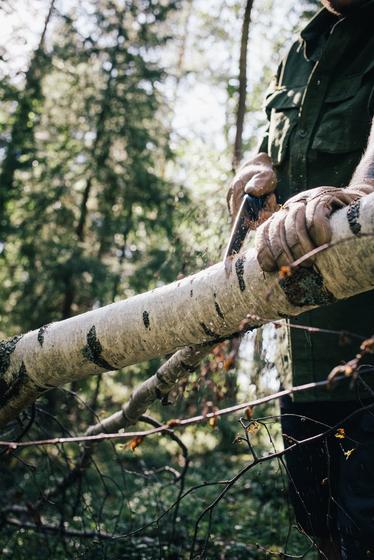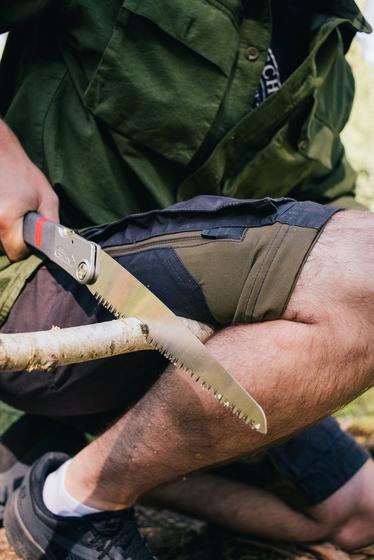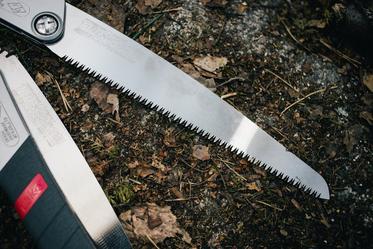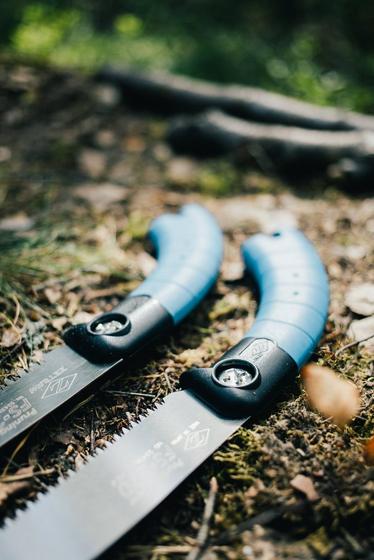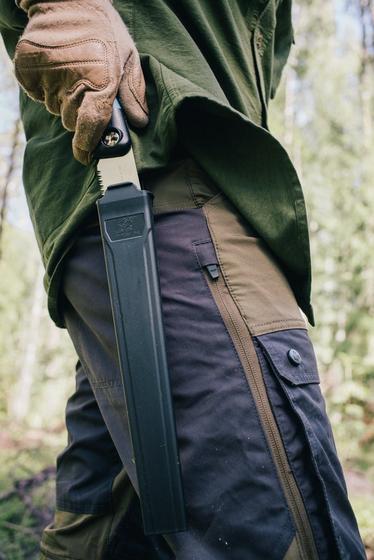Z-saw saws | Info and buying guide by Padraig Croke
The saw is as valuable a tool as your knife or your axe when it comes to outdoor and bushcraft essentials. A saw will save calories and time and will aid in wood processing for your campfire, as well as for sloyd and crafting activities. On top of this, the saw is safer than an axe, particularly for the less experienced outdoors person. So it is worth spending just as much time finding the right saw for your needs as with a knife or an axe. With the vast range of saw blade styles, not to mention sizes, shapes and characteristics, there is a saw for every type of user. One of Knivesandtools' newest products is from a Japanese company called Z-Saws, who have been around for a long time, and build tools for casual arborists to outdoors people and woodwork professionals alike. Let’s take a look at some of the Z Saw range and help you choose what is right for your needs.
Japanese Saw Tradition
The Japanese are renowned for their quality woodworking tools, particularly when it comes to hand saws for arborists and carpentry. So it should come as no surprise that Z-Saws have been making traditional hand saws since the 1940s. Since then, they have continued to innovate and expand on their hand saw models. They were also one of the first companies in Japan to introduce Hard Impulse-heating treatment, which is known as one of the great innovations for maximising saw tooth hardness. This works by rapidly heating just the tips of the saw tooth within milliseconds by means of squarewave impulses with a very high peak power to achieve a hardness level of HV800-950 (64.0 - 68.2 HRC), which is the maximum hardness that can be achieved on steel. They say that the secret to providing quality handsaws is down to their non-stop innovation and their decades-long experiences. Z-Saws and their replacement blades are a little less expensive than their perhaps more popular competitors Silky. This can be seen in the build quality and overall material choices, but they are by no means a bad choice! For all intents and purposes, Z-Saws are a fantastic choice for the more economically conscious user.
Using pull stroke blades
All the saws we are looking at in this range are pull stroke style blades. Pull stroke blades are perfect for pruning saws and for arborists because all the cutting power comes from the pull stroke action of the blade. This pull cut motion will make the blade much easier to use at awkward angles or when you are attempting to cut things at a height, applying a cutting pressure into your material with little effort needed. As well as this, the pulling action allows for more gentle and controlled strokes, so delicate and precise cuts can be made more easily. The forward motion should only be skirting across the cut and clearing it of any dust or pulp that would hinder a clean cut. If you have never used a pull stroke saw before then you may need to practice a little, as the motion feels usual if you are used to the more traditional type saw. People unfamiliar with this motion can very easily snap their blade by putting too much force in the push stroke and having the blade get caught and bend, resulting in a snapped blade. Fortunately, Z-Saws seem to be creating blades that are quite tough and flexible in comparison to their competitors.
Choosing the right Z-Saw for you
Z-Saw’s range spans across multiple types of hand saws, and they tailor their tools to suit the needs of many types of customer. From arborists and tree surgeons, to crafts people needing fine tooth saws, and outdoor and bushcraft enthusiasts, looking for a packable saw capable of delivering a powerful cutting force when called upon.
When choosing a saw, the specs and choices can seem a little overwhelming at first. But there are a few factors which need to be considered when you are choosing the right saw for your needs. These considerations include the blade's tooth size, length, ergonomics and packability. These elements go for all types of saw brands. What do you need to consider when choosing a saw for your own needs? Let us take a look at some of the specs and break down how they affect your saw choice.
Tips per inch
One of the biggest deciding factors is blade choice is its TPI (tips per inch). Generally speaking, the fewer teeth per inch on a blade, the larger those teeth tend to be, and the deeper the gullets. This means that with each stroke of the saw, a larger quantity of material is being cut and removed. As a result, a blade with fewer, larger teeth per inch will cut much quicker than one with more teeth. However, because of this aggressive cutting action, there is a greater chance that the material’s fibres will become torn, creating a rough finish. The more teeth per inch, the finer the finishing cut will be. So if making finer cuts is more preferable, for example if you are trimming a spoon blank or working a piece of wood for sloyd, then a blade with more teeth may be more preferable for your needs.
If you are looking for a more aggressive finish in the non-folding saws and power is what you're looking for, then the FS-245 is recommended, with 7 tips per inch. This is comparably more aggressive to the FS-270 with a TPI of 11 which will provide a beautifully smooth finish on your cut.
In the folding range (Tuck-In models) the 210 coarse model will give you a TPI of 8.5, even more aggressive than the FS models. However this blade is shorter and as a result requires more full strokes to get the job done. This would arguably be mitigated by the more aggressive teeth. The 210 fine is also more fine than the FS model, with a TPI of 12, resulting in a beautifully smooth cut, perfect for bushcraft projects that require a level of finesse.
Blade Kerf
Another consideration when you are choosing your saw type is the blade's kerf. This term is used to describe the thickness of the cut that a blade makes in a piece of wood as it cuts through it. The term is also sometimes used to describe the thickness of the blade, although often the kerf will actually be wider than the blade due to the cutting tips being slightly wider than the blade itself. The wider the kerf, the wider the cut will be. Woodworkers pay attention to kerf width, particularly where accuracy is essential. In our case, looking at pruning and folding saws, perhaps this is not such a critical factor. But it’s worth understanding this element of a saw's cutting blade, as it will affect not just how easy a blade can get through a piece of wood, but how much sawdust and waste is produced as a result of a cut. The thinner a cut, the less wood is wasted, however it will be more difficult to cut as you get deeper into the wood, with less space available for the dust to escape, resulting in a clogged cut that can become difficult. As a rule of thumb, a thicker kerf is preferable for outdoor saws.
In the FS models, the 245 coarse has a blade thickness of 0.90 mm, as well as the 210 course Tuck-in model. This will give you plenty of clearance for your dust to be removed as you are working through a piece of wood. This spec however only becomes important when you are cutting through larger chunks of wood.
Blade length and ergonomics
Considering all of these saws are relatively short and packable, blade length is arguably the least important factor when it comes to a blade's performance, as it can be balanced out with the previous two specifications we just looked at (kerf and tpi). As a general rule, the longer a blade, the fewer full strokes are going to be required to get through a piece of wood. If this is not a factor that realistically has a massive effect on performance with the sizes we’re talking about, then the other reason you might be looking at the blade's length is to assess its packability and compatibility. The saw style and length will also affect the ergonomics of the tool and how it is used.
If packability is not a concern for you, perhaps The FS models would suit your needs. These models come with an ambidextrous sheath that sits comfortably on a belt at your side. The plastic loop swivels on a hinge also, allowing the sheath to be moved back and forth if you are, for example, sitting on the ground with the saw sheathed. This would be a much more desirable configuration for someone who is pruning or cutting branches in a harness or up at a height, where perhaps only one hand is free to work at times. Easy access to the saw's sheath on your side would be essential here, mitigating the need to unfold a saw with two hands every time it was needed.
However, if you are not working at heights or one-handed, then perhaps the foldable saws are a better choice for your needs. The Tuck-in models offer more aggressive and finer blades than the FS models, accommodating for the shorter blades. The Tuck-in models also have a big advantage over the FS models when it comes to size. The blade folds into the handle, essentially doubling as the blade's sheath and halving the overall length of the tool. The disadvantage of this however, is that the saw requires two hands to unsheath.
With all of these considerations investigated by you the user, let us take a look at the two types of saws here and discuss the features unique to each of them.
FS Series Features
The FS series, as we looked at above, are a fixed length saw that will sit comfortably on the users side in a plastic sheath, which can be worn on either side of the body. This chunky, no nonsense sheath design is practical and unassuming and will no doubt be acceptable to any professional arborist or tree surgeon's needs. The curved plastic handle is very comfortable for prolonged use and can be worked with all day. Sitting comfortably in the hand is essential for tools like this, making it an enjoyable experience. The blade is easily replaced, removing the old blade using the chunky cross slot screw with a coin or your victorinox. Their high carbon, nickel-plated blades are tough, sharp and accurate!
Pros:
-
Longer blade lengths
-
Easy to operate and unsheath with one hand
-
Really comfortable and ergonomic design for all day use
-
Can be worn on the belt
Cons:
-
Less packable due to fixed length
-
Less aggressive TPI options available
-
Less control of cutting power or accuracy
Recommended for: Arborists, tree surgeons, gardening
Tuck-in Series Features
The Tuck-in series are designed with compatibility in mind. They are capable of delivering a powerful cutting action, at no cost to the user's carrying capacity. The simple foldable action of it means they can be easily slipped into the side of your backpack or even your trousers side pocket. The Tuck-in blades are both finer, and more aggressive, respectively, than the FS blades, offering very good specs at a smaller length.
The added length of the elastomer skinned Aluminum Die-casting compact grip, although not as comfortable to use over a long period of time, offers a more precise cut when it comes to power and accuracy. Holding the blade further back on the handle will give the user lots of cutting power! Further up and closer to the blade will make for a gentle and precise cut, if that is needed. As well as this, the blade's position can be hyper-extended. This is useful if the blade needs to cut something closer to the ground, eliminating the potential to scrape knuckles or hands off the ground when using the blade. As with the FS series, these blades are very easily removed and changed on the fly, using the chunky cross screw.
Pros:
- Compactable
- Plenty of control and accuracy due to the long handle
- Powerful blade specs
- Two blade positions offers lots of flexibility
Cons:
- Can only be opened with two handed use
- Can’t be worn on the hip
- Shorter blade length
Recommended for: Outdoors enthusiasts, bushcrafters, hikers
Padraig Croke
Padraig Croke is the host of the outdoors podcast Trial by Fire, which ran from 2018-2023. A graphic designer and photographer by day, as well as an avid outdoorsman and bushcraft enthusiast, when he's not writing for us he's usually out in the field making film or taking photographs.

You can find his work at www.padraig.me or by following him on instagram @padraigcroke
Thanks, Padraig, for this awesome review!
